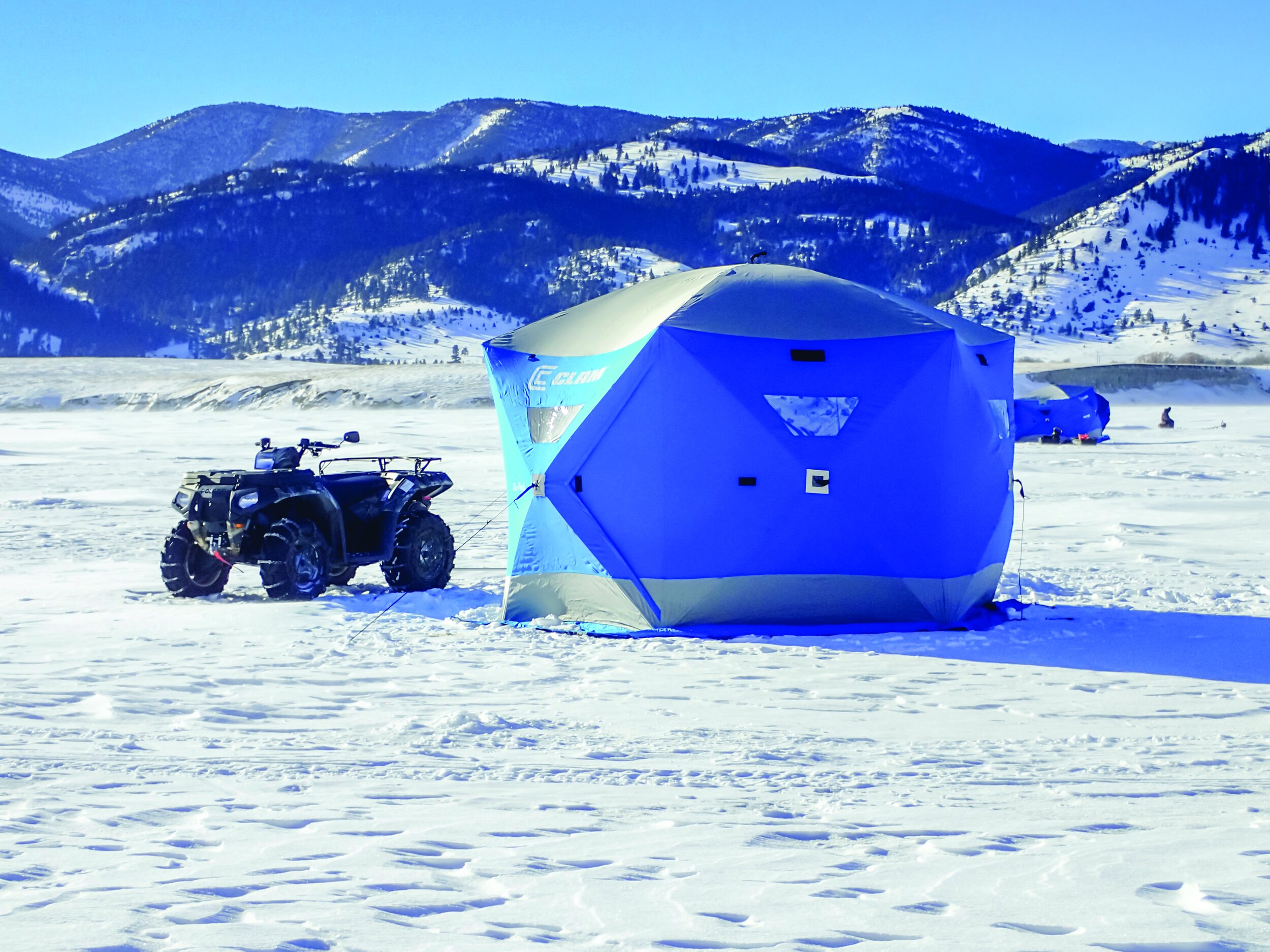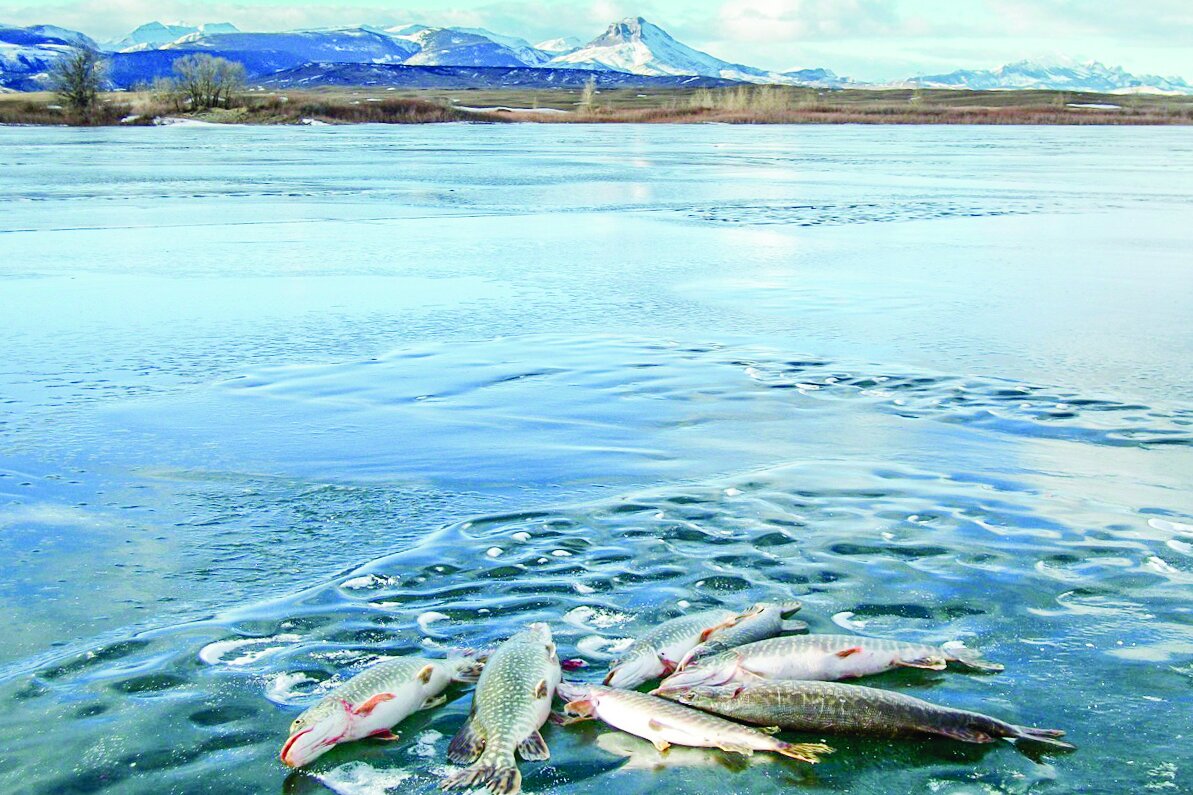Winter Fishing At Its Best
Across Montana
Photography by Amy Grisack
People think we’re nuts. To the uninitiated, sitting on a five-gallon bucket on a frozen lake in the bitter cold, looking down a hole for hours couldn't possibly be a good time. And they have a point. But sitting on a bucket in a tent warmed by our trusty propane heater while enjoying cocoa and snacks and reeling in a limit of Kokanee salmon, or perch for that matter, is a different scenario.
My husband, Grant, is a fisheries biologist by profession, and while he has his thumb on the pulse of all fishing styles, ice fishing has been his obsession since childhood. Now, he aims to share that passion with our boys, Sam and John, so it’s where we spend our winter pastime.
Of the most obvious wonders of ice fishing is the ice itself. It’s common to see people and houses dotting frozen lakes early in the season, and technically, anywhere with four inches of clear, hard ice is considered safe – supposedly. However, there’s no such thing as safe ice. That said, we don't venture out until it's at least 8 inches thick, and still use caution. I'll likely never be comfortable with the sound the ice makes as it’s forming, despite the fact that “singing” ice is a good sign. When a crack comes screaming across the lake and makes the water jump in your fishing hole, you certainly think twice about being one the ice.
Growing up in Great Falls, Montana, Grant fished Pishkun Reservoir, Lake Francis, Tiber, Holter, and many other popular waters in the region. We met when he worked in the Flathead Valley and he introduced me to ice fishing, typically on Smith Lake west of Kalispell. Ice fishing was an inexpensive activity we could enjoy together. We couldn’t afford a tent at the time, so he built the four-foot square “Perch Palace” out of lumber, and we skidded it to our preferred location, sacking up perch in shallow waters.
Many can enjoy ice fishing as the equipment doesn’t need to be fancy. In the early days, we chose nice weather, and sat outside in the sunshine on buckets. Eventually, we were gifted a couple ice houses, making it much easier to stay warm in less than perfect conditions. Mr. Heater coupled with the ice house made it comfortable even when it was below zero or blowing, both common occurrences in the area. Aside from shelter or a bucket on a warm day, a short ice fishing rod, some Swedish pimples and maggots, and an auger is all that is needed.
We have used fish finders at times to better gauge the depth of the fish, and an underwater camera is especially fun when lots of fish are busy mocking us from below as they swim up to the bait, nibble and leave.
It’s also important to stay comfortable, so good boots and chemical hand warmers by your toes are game changers. Warm feet make the rest of the body warm as well. As with any Montana winter activity, dress in layers because it can become surprisingly warm on sunny days.
“Go get good gloves. Good gloves are a necessity… and cheese curds,” Sam added, with a nod to our go-to snack for any ice fishing adventure.
“You fight the fish differently. I like pulling the fish straight up instead of using skill.”
Returning to Great Falls 16 years ago, Grant looked forward to fishing the excellent waters of his childhood and sharing those with our own boys. Our sons have accompanied us from a young age on ice fishing expeditions, catching everything from perch to pike.
As a mother, it is admittedly nerve-racking watching kids around larger holes, so during those early days, Grantdidn't drill a hole larger than 8 inches. Even so, seemingly every trip included at least one kid landing a foot in the water, which is why I packed enough for a six-month arctic expedition – a habit I haven’t shook. The key to those early excursions was bundling in warm clothes, packing an extra change of clothes, and enjoying plenty of special treats. As soon as we were set up to fish, the boys were ready for cocoa or snacks – part of the cherished tradition as cocoa always tastes better outside.
We were often targeting perch on Holter, and the boys usually had more patience than I did jigging, mesmerized as they stared into the depths of the water. Perch fishing is enjoyable when there are lots of them, even if they’re small. However, Grant really loves going after pike and is the tip-up master. Some view fishing with tip-ups as a passive means of catching them, but that’s not necessarily the case. At times, it's a scurried frenzy running from flag to flag, especially as Grant spaces them to a distance similar running suicides during basketball practice. Still, the sight of a flag up is exciting and spurs an adrenalin rush. Sam and John both prefer pike fishing as well.
“You fight the fish differently. I like pulling the fish straight up instead of using skill,” Sam joked.
John also likes pike as they’re a big, gnarly fish, and his goal is to catch one jigging on the rod. He’s experienced the fight both trout and perch can bring and looks forward to feeling a pike tug on the line.
Some years of experience taught me there is finesse involved in pulling a fish up on the tip-up. Instinctively, the boys and I would grab the line and yank it before pulling it up as fast possible. But after rigorous coaching from Grant, we learned to wait a bit and see if the spool on top was moving, indicating whether the pike was still hooked. Then, the best practice is a sharp tug to set the hook followed by a slow pull up, avoiding tangling the line. As an expert knot creator, my priority is a fish on the ice, and I know Grant will untangle the line for me.
Some of our recent favorite fishing opportunities have been with Kokanee salmon around Helena, with varied luck. Some days present a brief flurry of activity while others see a school come through and it’s one fish after another –my kind of fishing.
While there is still ice on the lakes, grab a rod, drill a hole, and see what memories you catch with your own friends and family this winter.




